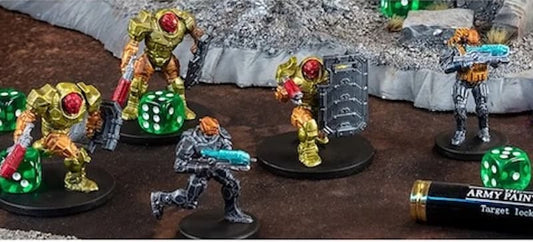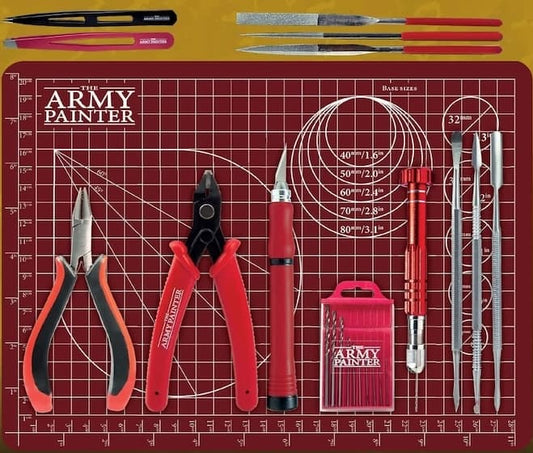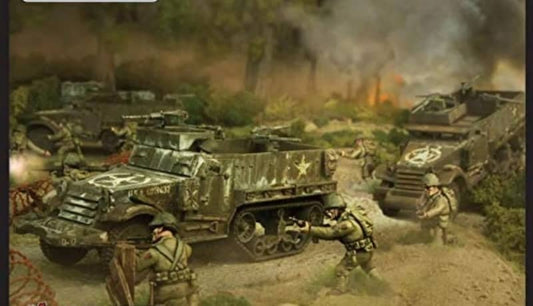A major challenge for the miniature painter is the ability to paint fine details. If you're looking for ways to improve your skills in this area, it can be helpful to think of the old saying "slow is smooth and smooth is fast." What does this mean? Well, read on to learn about how this applies to painting details and other helpful tips for how to paint details on your miniatures.
With many years of painting miniatures on commission, I've picked up a few principles that I return to when painting details. Condensed into a few tips and hobby recommendations, these should give you a jumpstart into the finer points of miniature painting.
Let’s begin! Here are 7 things you can do to improve your ability to paint details better on models, miniatures, or whatever scale hobby you’re working on!
1. Use the Appropriate Brush
One of the most important things you can do when painting details is to use the appropriate brush. This may seem like a no-brainer, but it's worth mentioning because it's so important! The wrong brush will make it difficult, if not impossible, to get the level of detail you're looking for.
For those starting out and afraid to damage their hobby brushes, try using synthetic bristled brushes for most of your work, like those in the Army Painter Starter Brush Set.

After you've gotten comfortable with those, you can start trying sable brushes. Sable brushes hold a finer point and spring back to their original shape better than synthetic bristles. The Winsor & Newton Series 7 paint brush comes to mind as a popular sable brush. It has ideal qualities for painting very fine details. The trouble with sable brushes, however, is that they're more (much more) expensive and require more regular care than synthetic bristles.

Army Painter has a Wargamer line, which is a good compromise, mixing sable with synthetic brushes. This keeps most of the sable-character in the bristles, while keeping the overall cost down.
They are a high value, durable paint brush that I recommend for any miniature paint of any skill who wants to improve their ability to paint with more precision on a regular basis.

2. Slow and Smooth
This is where the saying "slow is smooth and smooth is fast" comes into play. When you're painting tiny details, it's important to take your time and be as precise as possible.
By taking your time and being precise, you can avoid making mistakes and having to go back and fix them. This will save you time and frustration in the long run. Yes, it feels like this would take forever, but it will help you get the job done more quickly and efficiently. Go slow with details, to paint them faster.
3. Invest in the Best Lamp for Painting Miniatures
The professional miniature artists out there use good light sources to see the small details they are painting. This is why you should too. Using a magnifying lamp will help you see the tiniest details on your miniatures and make them easier to paint.

Don't assume the super bright office lamp you picked up from the budget shelf in a department store will suffice. It probably won't. There's a reason why artists equipment is expensive...not that you have to spend a fortune, but you should get something that's going to help you do your best work.
4.Use a Light Touch
Another important factor to consider when painting details is the amount of pressure you're applying to your brush. This is something that takes a bit of practice to get a feel for, but it's important to be aware of because it can have a big impact on the results. Too much pressure will cause the paint to blob or streak, while too little pressure will make it difficult to get a consistent line.

The amount of paint that flows off your brush is controlled directly by how much pressure you apply to the bristles against your model's surface.
There's no magic formula for the perfect amount of pressure, but as a general rule of thumb, you want to use as little pressure as possible while still getting a consistent line.
5.Use Multiple Thin Layers
When painting details, it's often best to build up the color gradually with multiple thin layers rather than trying to get it all in one go. This will give you more control over the color and allow you to build up to the level of opacity that you want. It's also less likely to help you retain those precious small details on the miniature, as you won't obscure them with thick pigment deposits.

Along with this idea, when you're painting tiny details, it's important to take your time and focus on one small area at a time. Trying to do too much at once will only lead to frustration and sloppy results. So take it slow, be patient, and enjoy the process!
6. Take Breaks
Another important tip for painting details is to take breaks often. When you're working on a small area for a long period of time, it's easy to lose focus and make mistakes. By taking regular breaks, you can help yourself stay refreshed and focused so that you can continue working at your best.
Miniature painting is a marathon of your mental capacity to hold focus. This is especially true for getting those details, textures, painted just right. How many specular highlight "dots" can you paint of the same size, without mistakes, in a 1515-minute painting session? A continuous 2-hour painting session?
Break up your big projects, those long stretches of painting, and you'll find your detailed work improve (see #2, "slow is smooth...").
7. Paint Models with Quality Hobby Paints
Finally, it's important to use the right paint for the job. Not all paints are created equal, and some are better suited for painting details than others.
For instance, cheap craft store paints just don't cut it when trying to paint fine lines and other small details. The pigments are usually coarser (or a mixed bag of fine and coarse which is just as bad), and can clog your brush, making it difficult to get a consistent flow of color.
A good quality hobby acrylic paint is easily thinned with water, produces good coverage without streaking (leading to visible brush strokes), and dries at a consistent rate. The latter is important because it allows you to predict how the paint will behave, making it easier to get the results you want.
So, overall, when it comes to choosing the best paint for painting details, it's important to consider the type of paint, the level of opacity, and the consistency. These are all important factors that will impact the results you're able to achieve.
Recommended Brushes and Paints
The Army Painter Brush Selection
This detailing brush set has a range of acrylic paint brushes to assist any wargamer in speed painting to a high level of detail without breaking the bank, from broad to extremely fine pointed tip.
For improving your ability to paint details, my suggestion is to start with the smallest brush you feel comfortable with, then work your way up in size. If you learn to use the biggest brush possible, while maintaining good fine-detail control, then you'll not only speed up your paint jobs, but you will be able to paint for longer periods of time without getting tired.

The Wargames Delivered Mega Selection Hobby Paint Set
The Army Painter and Wargames Delivered Mega Hobby Paint Set was created for war game enthusiasts of all kinds. Even if you've only recently started enjoying painting miniatures or have been around the battlefield for some time, you'll appreciate this full hobby bundle of paints and starter tools and accessories.

Well, there you have it! If these sets don't cover what you're looking for, there are other collections we have that will fit any need and budget. Check them out!
Conclusion
Painting details on a miniature can be a challenging but rewarding process. By following these tips, you can improve your skills and paint with greater precision and control. Remember to take your time, use thin layers of paint, and focus on one small area at a time.
Finally, forget the idea that you need to speed up. Go slow, and you'll find yourself painting all those finer bits on your miniatures with a speed that blinks by you...because you're having fun.
Did you find this article helpful? Want more quick insights like these? Let us know with a comment below!
Also check out The Army Painter and Wargames Delivered Mega Hobby Paint Set: A Detailed Look!




2 comments
Thanks for your interesting article on miniature painting. As a war gamer and a model railroader I’ve painted some miniatures in my career and I believe following your advise will improve my skill in the future. Thanks again, Rich De Rosa
Thanks for this article. I’ve be painting in water color since college, and realize the impotence in a quality brush. Using a quality brush in scale models is no different. I’ve been back in this hobby for a year and have had trouble painting detail because my hands might become shaky. Any suggestion for us older fellas for shaky hands?
As I stated, I really enjoyed your article and would be interested in obtaining more information if it is available.
Thank you,
G. Ginn